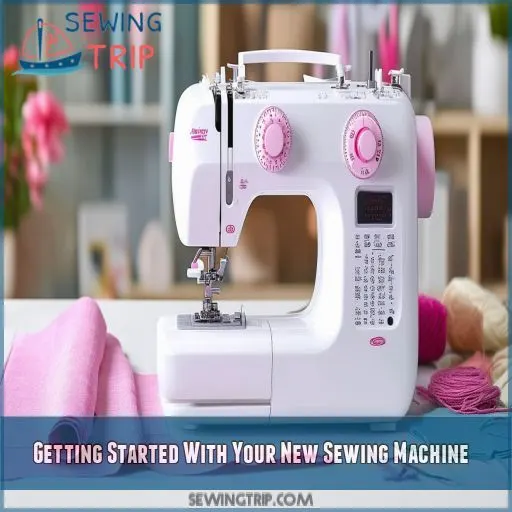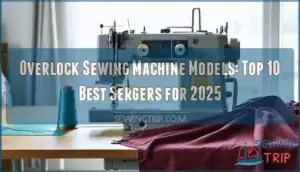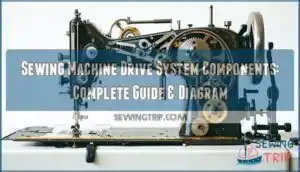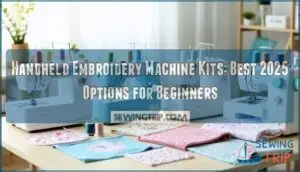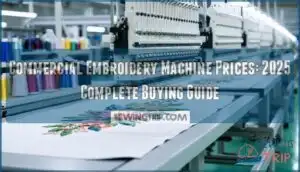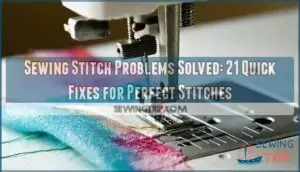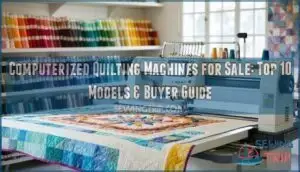This site is supported by our readers. We may earn a commission, at no cost to you, if you purchase through links.
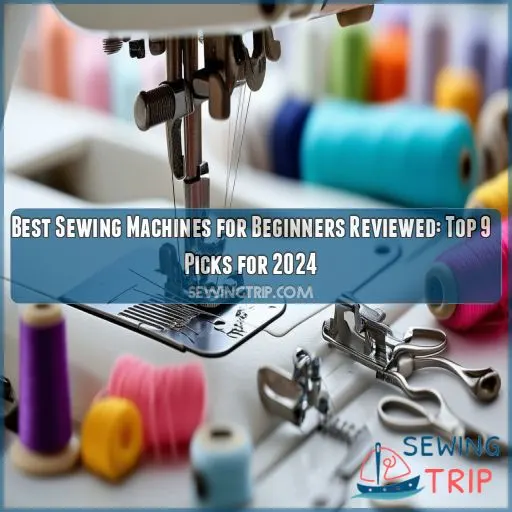 The sewing machine world may seem intimidating for beginners, whether you are asked questions about stitches, features, or overall performance.
The sewing machine world may seem intimidating for beginners, whether you are asked questions about stitches, features, or overall performance.
Our 2024 best sewing machine guide for beginners may be helpful. In this article, we will examine nine top choices while noting their functions, ease of use, and value for money.
With our guidance, you will hugely boost your chances of confidently choosing one that will suit your needs, skill level, and budget. Let’s get down to the nitty-gritty!
Table Of Contents
- Key Takeaways
- Understanding Sewing Machine Types for Beginners
- Key Features to Look for in Beginner Machines
- 9 Best Sewing Machines for Beginners
- 1. Brother CS6000i Sewing Quilting Machine
- 2. Singer Heavy Duty Sewing Machine
- 3. Janome HD1000 Heavy Duty Sewing Machine
- 4. Magicfly Mini Sewing Machine with Extension Table
- 5. Bernette 35 Swiss Design Sewing Machine
- 6. Brother XR3774 Sewing and Quilting Machine
- 7. Brother CS7000X Sewing Machine
- 8. Brother SE700 Sewing Embroidery Machine
- 9. Janome Sewing Quilting Machine
- Choosing the Right Machine for Your Needs
- Getting Started With Your New Sewing Machine
- Frequently Asked Questions (FAQs)
- Conclusion
Key Takeaways
- Finding the perfect sewing machine for you is like finding a needle in a haystack, but with our guide, you’ll be sewing with confidence in no time!
- Whether you’re a seasoned pro or just starting your sewing journey, there’s a machine out there that will fit your needs and budget.
- Don’t be afraid to ask for help when choosing a sewing machine. There are plenty of resources available to help you make the best decision for your needs.
- With the right sewing machine, you’ll be able to create beautiful projects that will last a lifetime. So what are you waiting for? Start sewing today!
Understanding Sewing Machine Types for Beginners
You will have to know how to differentiate between mechanical and computerized sewing machines as a beginner or even learn about the type of bobbin used. You’d also want to consider availability in terms of stitches and presser feet—both things that can profoundly change your sewing experience and the kind of projects you can take on.
Mechanical Vs. Computerized Machines
When choosing a sewing machine, you’ll encounter two main types: mechanical and computerized. Each has its pros and cons for beginners. Here’s what you need to know:
- Mechanical machines offer simplicity and affordability
- Computerized models provide more features and precision
- Tension adjustment differs between the two types
- Stitch selection varies in complexity
Mechanical machines require manual adjustments, while computerized ones offer automated settings. Your choice depends on your comfort level with technology and desired sewing capabilities. Remember, both can produce fantastic results in the right hands!
Importance of Bobbin Type
In choosing a sewing machine, it’s greatly influenced by the type of bobbin. Of the various bobbin types available in the market, two important ones are the top-loading and the front-loading. The following will provide a quick comparison.
| Feature | Top-Loading | Front-Loading | Class 15 (Universal) |
|---|---|---|---|
| Ease of Use | Easier | More Complex | Versatile |
| Tension Control | Less Precise | More Precise | Moderate |
| Visibility | Clear | Limited | Varies |
| Capacity | Smaller | Larger | Standard |
Top-loading bobbins are easier for beginners, while front-loading types allow better control of the sewing tension. A Class 15 is universal for most machines. Again, remembering to use the correct kind of bobbin will take you a long way in your sewing journey!
Stitch and Presser Feet Options
After considering bobbin types, let’s explore stitch and presser feet options. You’ll want a machine that offers:
- Basic stitches (straight, zigzag, buttonhole)
- Decorative stitches for creative projects
- Specialty presser feet for specific tasks
- Adjustable presser foot pressure
- A variety of stitch widths and lengths
These features give you freedom to tackle diverse projects. Remember, more isn’t always better – focus on quality and versatility that matches your sewing goals and skill level
Key Features to Look for in Beginner Machines
As a beginner, the first things you’ll look for while choosing a sewing machine are features that make your sewing journey very easy and enjoyable. Three of the most desired features would be one with an automatic buttonhole function, availability of an extension table, and overall ease of use and maintenance.
Automatic Buttonhole Function
When choosing a beginner’s sewing machine, an automatic buttonhole function is a game-changer. You’ll find this feature on many computerized sewing machines, making buttonhole creation a breeze. Let’s explore why it’s so valuable:
| Feature | Benefit | Skill Level |
|---|---|---|
| One-step process | Saves time | Beginner |
| Multiple styles | Versatility | Intermediate |
| Consistent results | Professional look | Advanced |
With an LCD display guiding you, you’ll master buttonhole placement and reinforcement methods in no time. It’s like having a mini sewing tutor at your fingertips!
Extension Table Availability
While auto buttonholes are most helpful, don’t forget about an extension table. This helps when first-time sewers deal with big projects.
Look for a sturdy, lightweight table that fits your machine. The larger it is, the more accommodating it is for quilting and garments. Some models offer integrated storage provisions that can be very helpful.
Remember that a good extension table will make a significant difference in your sewing experience
Ease of Use and Maintenance
While an extension table allows additional workspace, for a beginner, ease of use and low maintenance is essential. You’ll desire a machine that’s easy to operate and maintain in perfect condition. Look out for features that Lesson the learning curve and reduce maintenance costs:
- Automatic needle threader
- Adjustable width and length of stitches
- Instructions on cleaning and oiling
These very features ensure that you’ll spend more time sewing and less time troubleshooting, thus giving you the confidence to master this new hobby.
9 Best Sewing Machines for Beginners
You’ll find a range of excellent options for beginner sewing machines, from the versatile Brother CS6000i to the heavy-duty Singer and Janome models. Whether you’re looking for a basic machine like the Magicfly Mini or a more advanced computerized option like the Brother CS7000X, there’s a sewing machine on this list to suit your needs and budget
1. Brother CS6000i Sewing Quilting Machine
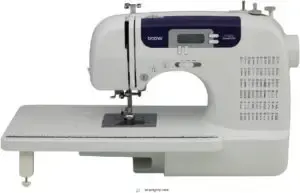
You’ll love the Brother CS6000i for its very user-friendly features and versatility. First off, it’s an excellent sewing machine for beginners, with 60 built-in stitches that will make it perfect for quilters, too.
There’s an LCD screen to select the stitches easily and a drop-in top bobbin to ensure smooth sewing. At only 13 pounds, it’s compact enough for portable classes and sewing on the go.
Plus, you’ll have peace of mind with a 25-year limited warranty and free lifetime tech support.
Just a note: designed only for 120V outlets, so it’s best suited for use in the US
Best For: Beginners and quilters who want a versatile and easy-to-use sewing machine.
- 60 built-in stitches
- LCD screen for easy stitch selection
- Drop-in top bobbin for smooth sewing
- Not recommended for use in countries that do not support 120V AC
- Bilingual user manual (not specified which languages)
- Weight (13 pounds) may not be suitable for all users
2. Singer Heavy Duty Sewing Machine
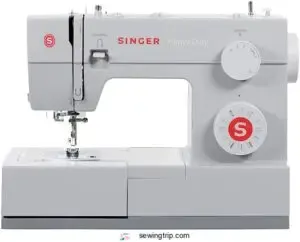
You’ll find the Singer Heavy Duty Sewing Machine to be a real trouper for all of your sewing escapades. With 23 built-in stitches, you have basic, stretch, and decorative options to get you through most works.
You don’t have to strain your eyes to thread a needle because of an automatic needle threader. You’ll then zip through the fabric at speeds of 1,100 stitches per minute.
Its heavy-duty metal frame gives the required stability and is equipped with accessories such as zipper and buttonhole feet that help extend your creative possibilities.
Be it a beginning sewer or a seasoned one, this machine has got you covered
Best For: Beginners and experienced sewers seeking a versatile and durable machine for various projects.
- Effortless threading with automatic needle threader
- High-speed sewing for efficient project completion
- Heavy-duty construction for stability and longevity
- Not suitable for heavy-duty industrial use
- May not be ideal for very delicate fabrics
- Limited stitch selection compared to higher-end models
3. Janome HD1000 Heavy Duty Sewing Machine
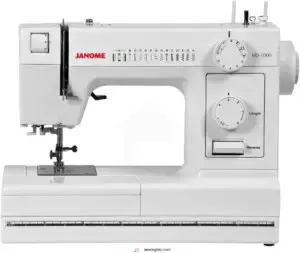
You will find the Janome HD1000 to be a perfect workhorse for your sewing projects. Its cast aluminum body makes it rugged, and the 14 built-in stitches will help you finish the basic stitches.
The 4-step buttonhole won’t be too fancy, but it still does its job rather well. You’re given a free arm for cuffs and collars, and with its drop feed, much more creative stitching is possible.
The automatic needle threader is a real eye-saver, and the included accessories leave room for growth.
And the weight—prepare thyself! This sewing machine means business!
Best For: Those seeking a durable and versatile sewing machine for basic projects.
- Sturdy cast aluminum body
- 14 built-in stitches for basic needs
- Free arm and drop feed for creative stitching
- Awkward on/off switch location
- Bobbin winding stop motion is not automatic
- Heavy metal body
4. Magicfly Mini Sewing Machine with Extension Table
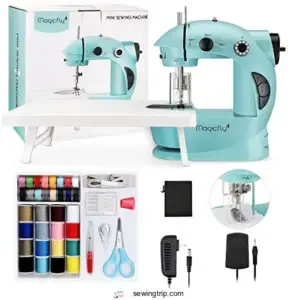
Looking for a compact sewing machine that won’t break the bank? The Magicfly Mini might be your perfect match.
This little powerhouse offers two-speed settings and can run on both AC/DC power or batteries, making it incredibly versatile. You’ll appreciate the extension table for larger projects and the LED lamp for better visibility.
While it lacks a backstitch function and has fixed stitch settings, it’s packed with accessories like 32 bobbins, needles, and a handy storage bag.
It’s an ideal choice for beginners or those needing a portable option
Best For: Beginners or those needing a portable option.
- Compact size and lightweight for easy storage and portability
- Versatile power options (AC/DC or battery) for use anywhere
- Extension table for larger projects and LED lamp for improved visibility
- Fixed stitch settings and no backstitch function
- Material not specified in the provided information
- Limited information on the type of stitches it can make
5. Bernette 35 Swiss Design Sewing Machine
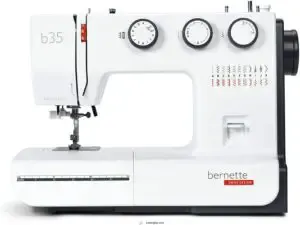
You’ll love the Bernette 35 Swiss Design Sewing Machine for its blend of simplicity and versatility. With 23 stitches and 7 presser feet, it’s perfect for beginners looking to grow their skills.
The automatic buttonhole function saves time, while the manual needle threader and thread cutter offer hands-on control. Don’t worry about storage – it’s got you covered with built-in space for accessories.
At 15.8 lbs, it’s sturdy yet portable. The 2-step presser foot lift and high piercing power make tackling various fabrics a breeze
Best For: Beginners looking to grow their sewing skills.
- Offers a wide range of stitches (23) and presser feet (7)
- Includes convenient features like automatic buttonhole function, manual needle threader, and manual thread cutter
- Provides ample storage space for accessories
- Does not have an automatic needle threader
- Thread cutter is manual, not automatic
- Weight (15.8 lbs) may be heavy for some users
6. Brother XR3774 Sewing and Quilting Machine
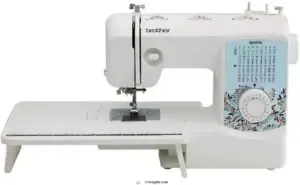
You’ll find the Brother XR3774 a solid choice for both sewing and quilting projects. It boasts 37 built-in stitches, giving you plenty of options to explore.
The automatic needle threader is a game-changer, saving you time and frustration. With its drop-in top bobbin and versatile free arm, you’ll breeze through various projects.
The wide table comes in handy for larger pieces, while the included 8 sewing feet expand your capabilities.
Keep in mind, it’s not the quietest machine, and the extension table can be a bit wobbly
Best For: Sewing and quilting enthusiasts seeking versatility and ease of use.
- 37 stitch options for various projects
- Automatic needle threader for effortless setup
- Versatile free arm for sewing cylindrical items
- Not quiet during operation
- Grips on the bottom of the machine may be inadequate
- Extension table can sometimes become loose
7. Brother CS7000X Sewing Machine
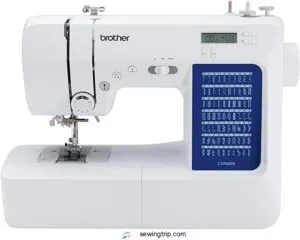
The Brother CS7000X is the all-around powerhouse that will have you sewing like a pro in no time. It offers 70 unique built-in stitches and an improved threader that makes breezing through any project easy.
The machine comes with 10 feet and a quilt guide to help expand your skills. You’ll appreciate its large workspace, which is handy when working on larger projects.
At 750 stitches per minute, you’ll finish tasks in a flash. Moreover, with the wide table, protective case, and trilingual manual, you’ll be thoroughly equipped for your sewing journey
Best For: Beginners and experienced sewers alike looking for a feature-rich machine with a great value.
- 70 unique built-in stitches
- Improved needle threader
- Large needle-to-arm workspace
- Intended for sale only in the US at 120 volts
- 14 pounds
- Made in Vietnam
8. Brother SE700 Sewing Embroidery Machine
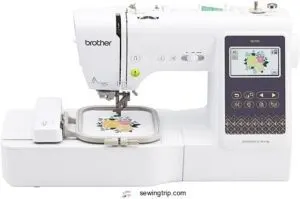
If you’re looking to explore both sewing and embroidery, the Brother SE700 is a fantastic choice. This versatile machine offers 103 built-in stitches and 135 embroidery designs, giving you plenty of creative options.
You’ll love the 3.7" touchscreen and wireless connectivity, which make selecting designs a breeze. With a 4" x 4" embroidery field and compatibility with the Brother iBroidery platform, you can easily expand your design library.
The automatic needle threader and drop-in bobbin simplify setup, while the included feet provide versatility for various projects
Best For: Hobbyists and beginners looking for a versatile machine to explore sewing and embroidery.
- Wireless connectivity for easy design selection
- 135 built-in embroidery designs and 103 built-in sewing stitches
- Compatible with Brother iBroidery platform for expanding design library
- Embroidery field is relatively small at 4" x 4"
- Some users may find the sewing speed of 710 spm to be limiting
- Limited number of included feet
9. Janome Sewing Quilting Machine
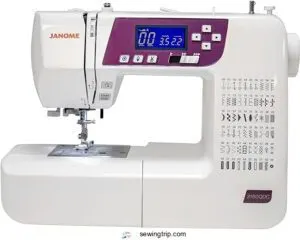
If you’re looking for a versatile machine that’ll grow with your skills, the Janome 3160QDC-G is worth considering.
This mint-colored beauty boasts a stainless steel frame and built-in stitches for both stretch and non-stretch fabrics. You’ll love the self-threader and thread cutter, saving you time and frustration.
The digital display makes selecting stitches a breeze, while the extension table gives you extra workspace. It’s portable too, perfect for sewing on-the-go.
Keep in mind, though, that some users have reported issues with thread jamming and the automatic threader
Best For: Beginners and experienced sewers looking for a versatile, durable, and easy-to-use machine.
- Durable construction with metal internal frame and gears
- Easy to use with digital display and self-threader
- Versatile with built-in stitches for various fabrics and a quilting kit available
- Some users have reported problems with jamming threads and automatic threader
- May be more expensive than other computerized machines
- Limited color options
Choosing the Right Machine for Your Needs
Pick a sewing machine that would suit your needs and budget. Durability must, therefore, be assessed; in fact, every well-built machine will be more suitable to serve you longer and grow with your skills.
Assessing Your Sewing Goals
Now that you’ve seen some of the top picks, consider your sewing goals. The type of machine to choose depends on:
- Project types: Will you do simple repairs or intricate quilts?
- Type of fabric: Are you working with light silks or robust denims?
- Stitch options: Do you want functional or decorative stitches?
Considering Budget Constraints
When considering budget constraints, you’ll find sewing machines at various price points. Don’t worry, there’s a perfect match for your wallet! Let’s break down your options:
| Price Range | Features | Best For |
|---|---|---|
| Under $100 | Basic stitches, portable | Occasional use |
| $100-$300 | More stitches, computerized | Regular hobbyists |
| $300+ | Advanced features, durability | Serious sewers |
Evaluating Machine Durability
When evaluating machine durability, consider how it handles various fabric types and maintains stitch quality over time.
Look for sewing machines that have undergone rigorous testing methodologies, including use with different materials and extended operation.
Check sewing machine reviews for insights on long-term performance and maintenance frequency.
A durable machine will save you time and money on repairs, allowing you to focus on mastering your craft and enjoying the freedom of creating
Getting Started With Your New Sewing Machine
Once you’ve chosen your new sewing machine, it’s time to get familiar with its basic setup and operation. Start by learning how to thread your machine correctly and understand the different stitch options available, then practice essential techniques like straight stitching and backstitching on scrap fabric to build your confidence
Basic Setup and Threading
Once you’ve got your new sewing machine, it’s time to master the basics. You’ll need to wind the bobbin, thread the needle, and adjust the tension. Don’t worry; it’s easier than it sounds! Start with the right needle for your fabric and set the stitch length. Here’s a quick rundown:
- Wind the bobbin like you’re wrapping a present
- Thread the machine as if you’re leading a tiny parade
- Adjust tension like you’re tuning a guitar
- Choose needles like you’re picking the perfect tool
- Set stitch length as if you’re adjusting your stride
Understanding Stitch Selection
When you’re ready to start sewing, understanding stitch selection is key. Your machine offers various stitches for different tasks. Here’s a quick guide:
| Stitch Type | Best For | Fabric Type |
|---|---|---|
| Straight | Basic seams | All fabrics |
| Zigzag | Finishing edges | Woven fabrics |
| Stretch | Knit fabrics | Stretchy materials |
Practicing Essential Techniques
Now that you have mastered the stitch choice, try some other essential techniques. Start with simple applications like straight seams and hems.
Build expertise on different types of fabric, weights of thread, and sizes of needles. Organize your projects by pattern complexity and consider specifications about fabrics.
As you build up confidence in your abilities, refer to the accessories usable with your sewing machine.
Remember that in sewing, practice goes a long way in perfecting one’s art
Frequently Asked Questions (FAQs)
What is the best basic sewing machine for home use?
For home use, the best basic sewing machine is the Brother XR It’s solidly built, offers several basic utility stitches, includes numerous feet, and has one buttonhole stitch, making it versatile and beginner-friendly
Which sewing machine has the least problems?
The Brother CS7000X generally has the least problems, thanks to its reliable performance, durability, and ease of use. Its automatic features and variety of stitches make it an excellent choice for beginners and advanced users alike
What is the most reliable brand of sewing machine?
The most reliable sewing machine brands are typically Brother, Singer, and Janome. They offer durability, consistent performance, and a wide range of features, making them a favorite among beginners and experienced sewers alike
How to choose a sewing machine for beginners?
Investigate key features like ease of use, variety of presser feet, automatic buttonholer, and good lighting. Consider machine type, bobbin system, local servicing availability, and standout features like computerized functions or extension tables
What is the best beginner sewing machine?
The best beginner sewing machine is the Brother CS7000X. It offers 70 stitches, 10 presser feet, automatic needle threader, extension table, and adjustable sewing speed. Its user-friendly features make it perfect for novices
Which Brother Sewing Machine is best for beginners?
For beginners, the Brother CS7000X is ideal due to its user-friendly interface, 70 built-in stitches, seven buttonhole styles, and ease of use. It’s versatile, reliable, and offers excellent value, making sewing simple and enjoyable
What is the best sewing machine for quilting?
For quilting, you can’t beat the Brother CS7000X. It features 70 stitches, 10 presser feet including a quilting foot, an automatic needle threader, and an extension table, making it ideal for handling all your quilting projects
Is a sewing machine good for beginners?
Yes, a sewing machine is great for beginners. With features like simple controls, easy-to-follow manuals, and basic stitch options, you’ll quickly get the hang of it and start creating projects in no time
How often should I oil my sewing machine?
You should oil your sewing machine after every 8-10 hours of use. Regular oiling keeps your machine running smoothly, prevents rusting, and extends its lifespan, so don’t skip this essential maintenance step
Which fabrics work best for practice sewing?
Studies show cotton is the best fabric for practice, being forgiving and easy to work with. Starting with cotton helps you gain control over your stitches, making it ideal for beginners to build confidence and skill
Can beginners sew thick materials like denim?
Yes, beginners can sew thick materials like denim with the right machine. Choose a heavy-duty model like the Singer Heavy Duty 4423, which can handle tougher fabrics smoothly and efficiently. Use the proper needle for denim
How do I troubleshoot common sewing machine issues?
Even sewing machines are known to act sometimes as unpredictably as life does. For the rest, check the positioning of the needle, thread tensioning, and cleanliness. Make sure that the machine is properly threaded and that the bobbin is in a proper position. Of course, use quality thread to avoid any jamming.
What are the benefits of using a walking foot?
A walking foot aids in feeding the multiple layers of fabric under the machine evenly, without slipping or puckering. This is especially great for quilting so that stitches will be smooth and aligned, making your work appear polished, and management of challenging fabrics easier.
Conclusion
Mastering the best sewing machine for beginners might seem like letting a thread pass through the hole of the sewing needle, but by using our guide, you can now make your cohesive decision.
If you’re into mechanical or computerized ones, focused on features such as an automatic buttonhole feature or other budget-oriented and durable picks topping your list, these nine options provide dependable performance based on specification.
Now that you’re more than adequately equipped with knowledge, start sewing and choose the suitable machine according to your needs and skill levels. Happy sewing!

